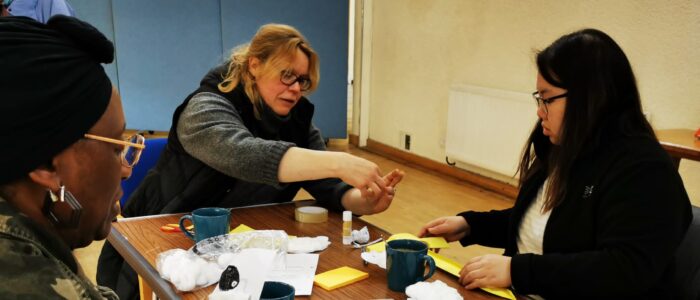Diary of a Creative English Trainer: Day 12

Did you hear what I said?
There are four skills that speakers of other languages need: reading, writing, speaking and listening. We often forget about listening, as it is something we kind of ‘do’ automatically. The work of our Creative English Programme has a special focus on speaking and listening, although it does incorporate elements of reading and writing, too.
So I have found myself thinking about how I make this skill of listening important to my students. Recently, in one of my classes, I had occasion to mention to a more able group that speakers of Urdu, Punjabi and Hindi were very likely to confuse the sounds ‘v’ and ‘w’. I also had an Argentinian lady and we talked about her difficulties with the ‘b’ and ‘v’ sounds – typical of Spanish speakers.
This was a revelation to them, as they had been complaining about how hard telephone calls are. They had been feeling like they were failing, because phone calls are so tricky. However, when we discussed it, my student from Pakistan quickly reminded us that we need body language clues to help us, which is why telephone calls are hard. And it helped to know that it is exactly the same for everyone!
In our Creative English session plans there is a huge variety of games and activities. For some of them, you may have been wondering why they have been included, as they do not seem to have any language development attached to them. For example, one game is called ‘Chinese mimes’, where no spoken language is used at all!
If you recall from our training, one reason for their inclusion is to help promote a sense of fun and to relax everyone, so that they feel more confident to contribute to speaking in front of other people.
A further reason is to provide opportunities for listening. Every session your students will need to listen to your instructions; this is a marvelous way to encourage careful listening. So, even the Chinese mimes are helpful, as everyone needs to listen to the leader’s instructions and explanations. It’s good to actually point this out to them, so that they know why you are doing the game.
Some of the activities are based around guided listening. For example, in Term 2 of the Creative English programme, there is a passage to be read aloud and the students are given questions to answer, based on what they hear. It is sensitively structured so there is plenty of support for weaker learners, and stronger learners get a boost to their confidence when they get all the answers right!
And sometimes you may hear someone making a mistake – like a lady did in my class this morning. We were chatting about hail, but she heard heel instead! It’s often the vowels that cause the problems! You must always decide whether or not to correct – it always depends on the confidence of your student and the appropriateness of an intervention.
You might want to encourage your students to listen to English television, rather than something on satellite or cable TV in their own languages. By using subtitles, they will be able to support their listening. I must admit that I have been known to do this in reverse when in France (i.e. telly on in French, with English subtitles) and I get very excited when I recognise sentences, especially those where the translator has cut the English short and missed out the details!


